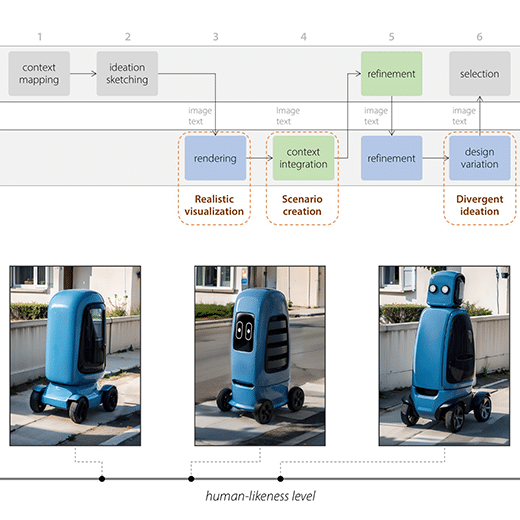IDSA publishes a selection of peer-reviewed academic education papers each year. These are collected during a community-wide open call period when design educators and practitioners submit materials for review by a group of judges serving on IDSA’s Academic Jury. The program also helps provide content for the annual Education Symposium, where some authors are invited to present their work from the stage to a live audience. To view the full Education Papers jury please visit meet the jury page.
A Transformative Methodology For Designers And Design Educators
Recent global issues like supply-chain collapse, chip shortages, global-warming, and other disruptive developments have a very strong impact on designers and the design world, affecting everyone’s wellbeing and future expectations. Design society’s progressiveness depends upon adapting to new movements
Author: Mekin Elçioğlu, PhD
Company / School: Kansas State University
- 2024
- Paper Type: Academic Research
- Education Symposium Theme: Design Disrupted
As humanity advances into an era of advanced technology, there has been a significant enhancement in our perception of the world and our interactions with it. This progress facilitates the discovery of novel modes of creative expression. This paper
Author: Yechen Zhu
Company / School: Rhode Island School of Design
- 2024
- Paper Type: Student Research
- Education Symposium Theme: Design Disrupted
Examining The Impacts Of Mainstream Design Education
The integration of Design Thinking/Design based learning/STEAM into secondary education has impacted the understanding of the role of design as a field. These effects show up in multiple ways; first through students’ confusion around the relationships between STEM and
Author: Chris Sancomb
Company / School: University of Connecticut
- 2024
- Paper Type: Case Study
- Education Symposium Theme: Design Disrupted
An Interdisciplinary, Educational Model For Design Thinking And Open-Source Technologies To Drive Community Engagement
While assistive toys and adaptive technologies exist, more often than not these types of products are expensive and not optimized for individuals’ needs. With tools such as web-based cloud modeling and 3D printing becoming increasingly more accessible to individuals
Author: Zachary Samalonis
Company / School: Thomas Jefferson University
- 2024
- Paper Type: Case Study
- Education Symposium Theme: Design Disrupted
How Data Embodiment Contributes To Cognitive Agency Over Data Bodies
The prevalence of IoT embedded products has made data capture near impossible to escape. With the omnipresence of data mining, the question of how we design data collection becomes increasingly important and difficult to address. Previous research in embodied
Author: Lydia Swedberg
Company / School: Malmö University
- 2024
- Paper Type: Student Research
- Education Symposium Theme: Design Disrupted
Using Design Research Methods & New Tools With City Government Stakeholders To Inform Future City Plan
The transition away from car-centrism to multi-modality in U.S cities and the integration of emerging trends and technologies such as smart cities, vehicle autonomy, and a shared economy, are all increasing the complexities and require new methods for city
Author: Alejandro Lozano Robledo, Henry Levesque, Domagoj Bui
Company / School: Future Mobility Design Laboratory, Digital Futures, University of Cincinnati
- 2024
- Paper Type: Case Study
- Education Symposium Theme: Design Disrupted
This study explores generative image AI’s capacity to rapidly create multiple realistic renderings for human-robot interaction (HRI) research. By utilizing freehand sketches and employing an iterative process of rendering generation and refinements in Vizcom and Photoshop, variations of service
Author: Yong-Gyun Ghim, Joe Curtsinger
Company / School: University of Cincinnati
- 2024
- Paper Type: Case Study
- Education Symposium Theme: Design Disrupted
Broader Distribution Of Level 2 Charging System To Improve User Experience
This study addresses on gap between the current EV charging services and EV owner’s need by evaluating public EV charging infrastructure from a user satisfaction perspective. It proposes a dual-track strategy, maintaining Level 3 fast chargers for long-distance travel
Author: Suochun Fang, Min Kang
Company / School: University of Houston
- 2024
- Paper Type: Student Research
- Education Symposium Theme: Design Disrupted
Transforming Food Access Paradigms through the Design of Food Agentic Technologies
Numerous communities across America struggle with limited access to fresh produce and affordable, healthy foods, fueling a crisis in obesity and corresponding health complications. The conditions that give rise to these ‘food deserts’ are the product of commodified social,
Author: Ann-Marie Conrado
Company / School: University of Notre Dame
- 2024
- Paper Type: Academic Research
- Education Symposium Theme: Design Disrupted
Prototyping Methods In Biomaterials Manufacturing
A selective transition from conventional plastics, metal, and timber to renewable bioplastics presents significant opportunities for curbing emissions and landfill loads. When bioplastics are blended with crop fiber, an abundant waste product of agriculture, they make resilient composites that
Author: Jason Carley
Company / School: University of Notre Dame
- 2024
- Paper Type: Case Study
- Education Symposium Theme: Design Disrupted









